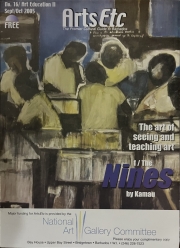
ArtsEtc Inc. 1814-6139
All works copyrighted and may not be reproduced without permission. ©2013 - hoc anno | www.artsetcbarbados.com
All works copyrighted and may not be reproduced without permission. ©2013 - hoc anno | www.artsetcbarbados.com



Published: Sept/Oct 2005
Theme: Art Education II
Cover: Eleven Plus by Hartley Alleyne, National Art Collection. (Used by permission of the Ministry of Education.)
Contributors: Kamau Brathwaite, Kelly Chase, Rob Leyshon, Fay Martindale, Esther Phillips, Wayne Quintyne, Dianne Squires

BackPage Say #16
Cruelty to Art
By Linda M. Deane
It was like sniffing a carton of milk that had passed its sell-by date. You know it’s bad, but you do it anyway. That’s how it was listening to call-in programs following the unveiling of the Rock Hall Monument of Freedom in August. After just five minutes, I wanted to pelt my radio outside. But I resisted and kept sniffing because the responses revealed truckloads about how we look at art.
The monument by architect Stanton Haynes (of Eagle Hall Market and Lawrence Johnson Roundabout fame) was the winning design in a 2002 public competition to commemorate Barbados’ first free village. The twenty feet tall bronze statue is vaguely abstract: three emaciated figures—a family—representing freedom and survival.
Haynes is nothing if not consistent in that you either love his work or hate it. Barbadians are free to love or hate any piece of art. What was disappointing was hearing callers express intolerance for publuc abstract art, callers who valued only realistic busts and statues. Callers who said abstract forms should be confined to gallery walls, with artists on hand to explain themselves.
To his credit, one moderator countered the prevailing mood, saying he welcomed art that was different and non-traditional. But we needed to hear artists and designers calling in, not with explanations or in the monument’s defense, but championing artistic freedom.
Barbadians have not been taught to embrace the non-traditional. We seem content with what we know or lap up from abroad. Anything else, and our fears pour out in hostile doses. In addition, we have not been taught or encouraged to freely and creatively self-express. This suppressed energy leaks out how and where it can: in lawless driving, illegal public service vehicle art, the ripeness of our everyday language and, for one day a year, in the unrestrained, near-naked wuk-up of the generic-costumed masses.
If we challenged ourselves to engage in and accept freer artistic and creative expression, to understand that there is room for all art forms—traditional and modern, representational and abstract—there would be less chance of going into shock whenever Mr Haynes, or any of us, self-expresses freely outdoors. Not to accept the challenge would be, to borrow from the great jazz pioneer W.C. Handy, cruel to art.
This editorial is by ArtsEtc founding editor (graphics) Linda M. Deane.